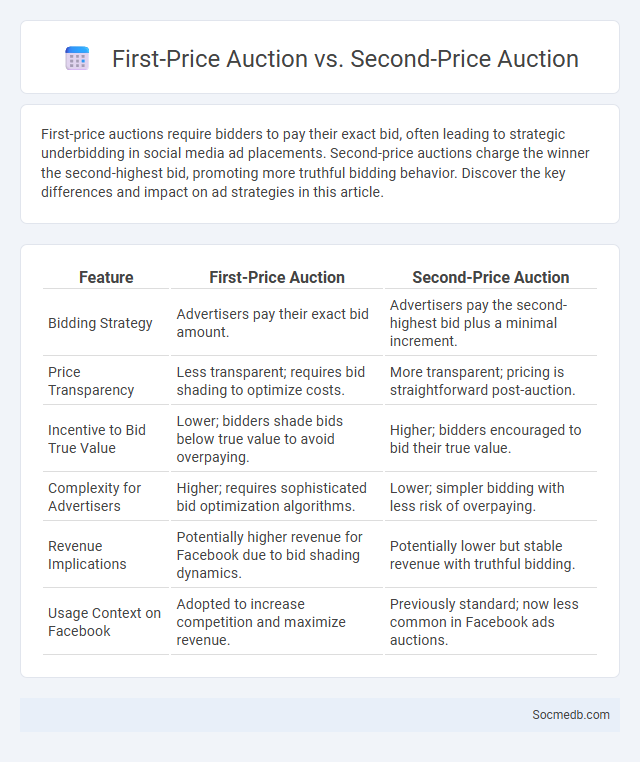
Photo illustration: First-Price Auction vs Second-Price Auction
First-price auctions require bidders to pay their exact bid, often leading to strategic underbidding in social media ad placements. Second-price auctions charge the winner the second-highest bid, promoting more truthful bidding behavior. Discover the key differences and impact on ad strategies in this article.
Table of Comparison
| Feature | First-Price Auction | Second-Price Auction |
|---|---|---|
| Bidding Strategy | Advertisers pay their exact bid amount. | Advertisers pay the second-highest bid plus a minimal increment. |
| Price Transparency | Less transparent; requires bid shading to optimize costs. | More transparent; pricing is straightforward post-auction. |
| Incentive to Bid True Value | Lower; bidders shade bids below true value to avoid overpaying. | Higher; bidders encouraged to bid their true value. |
| Complexity for Advertisers | Higher; requires sophisticated bid optimization algorithms. | Lower; simpler bidding with less risk of overpaying. |
| Revenue Implications | Potentially higher revenue for Facebook due to bid shading dynamics. | Potentially lower but stable revenue with truthful bidding. |
| Usage Context on Facebook | Adopted to increase competition and maximize revenue. | Previously standard; now less common in Facebook ads auctions. |
Introduction to Auction Types in Digital Advertising
Auction types in digital advertising primarily include Real-Time Bidding (RTB), Private Auctions, and Programmatic Direct deals. RTB allows advertisers to bid for individual ad impressions in real-time through open auctions, maximizing reach and targeting precision. Private Auctions restrict participation to select advertisers, ensuring premium inventory access, while Programmatic Direct involves fixed-price buys for guaranteed impressions, balancing efficiency and control.
Understanding First-Price Auctions
In social media advertising, understanding first-price auctions is crucial for optimizing your campaign budgets and maximizing ad placements. First-price auctions require advertisers like you to bid the highest amount you are willing to pay per impression, with the winning bidder paying exactly their bid. Mastering this auction model helps improve targeting efficiency and ensures better control over ad spend in competitive social media environments.
Exploring Second-Price Auctions
Second-price auctions, also known as Vickrey auctions, are increasingly applied in social media advertising to optimize bidding strategies and maximize ad revenue. Advertisers submit their bids for ad placements, but the highest bidder wins while paying the second-highest bid, which encourages truthful bidding and efficient market pricing. Platforms like Facebook and Twitter leverage this auction model to allocate ad space dynamically, improving both user targeting and advertiser ROI.
Overview of Ad Auctions in Online Platforms
Ad auctions in online platforms are automated processes that determine the placement and cost of advertisements based on bids and targeting criteria. These auctions use real-time bidding (RTB) systems where advertisers compete for ad space by specifying maximum bids and audience segments. The platform evaluates bid amounts, ad quality, and relevance scores to optimize ad delivery and maximize revenue while enhancing user experience.
Key Differences: First-Price vs Second-Price Auctions
First-price auctions in social media advertising require advertisers to pay the exact amount of their winning bid, making bid strategy and accurate value assessment crucial for cost-efficiency. Second-price auctions charge the winner the amount of the second-highest bid, encouraging bidders to bid their true value without overpaying, which often results in more stable and predictable ad costs. The choice between first-price and second-price auction formats impacts budget management, bid strategy, and campaign performance on platforms like Facebook, Instagram, and Twitter.
Impact of Auction Type on Bid Strategy
The impact of auction type on bid strategy significantly influences your social media advertising success by determining how your bids compete for ad placements. Different auction models, such as second-price or first-price auctions, require tailored bidding approaches to maximize ROI and maintain cost efficiency. Optimizing your bid strategy according to the auction type ensures better targeting, higher engagement rates, and improved ad performance across platforms like Facebook, Instagram, and LinkedIn.
Transparency and Fairness in Digital Auctions
Transparency and fairness in digital auctions are critical for building trust among users and advertisers on social media platforms. Implementing clear algorithms and providing detailed bidding data ensures that all participants understand how ad placements and costs are determined. Advanced monitoring systems help detect fraudulent activities and prevent manipulative practices, promoting a level playing field for advertisers.
Pros and Cons of First-Price and Second-Price Auctions
First-price auctions in social media advertising allow you to pay exactly what you bid, offering transparency and control over your budget but may lead to overpayment in highly competitive markets. Second-price auctions charge you just above the second-highest bid, often resulting in cost savings and reduced bid shading, yet they can obscure true market value and complicate bid strategy. Understanding these mechanisms helps optimize ad spend and campaign performance on platforms like Facebook and Twitter.
How Ad Auctions Shape Programmatic Advertising
Ad auctions determine the price and placement of ads in programmatic advertising by using real-time bidding among advertisers based on user targeting and ad relevance. Social media platforms leverage these auctions to optimize ad delivery, ensuring advertisers reach highly specific audiences while maximizing revenue through dynamic pricing models. The auction mechanism balances supply and demand, influencing campaign performance by prioritizing ads that generate higher user engagement and advertiser bids.
Choosing the Right Auction Model for Advertisers
Selecting the right auction model for your social media advertising is critical to maximize return on investment and ensure your ads reach the ideal audience. Different platforms offer models like second-price auctions or cost-per-click bidding, each optimizing for various outcomes such as engagement or conversions. Understanding these options helps you tailor your strategy to align your budget with your campaign goals effectively.
 socmedb.com
socmedb.com